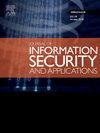Image encryption algorithm based on DNA sequence-driven key scrambling and secure hashing
IF 3.7
2区 计算机科学
Q2 COMPUTER SCIENCE, INFORMATION SYSTEMS
Journal of Information Security and Applications
Pub Date : 2025-07-08
DOI:10.1016/j.jisa.2025.104140
引用次数: 0
Abstract
In the evolving landscape of secure image transmission, safeguarding sensitive visual information against unauthorized access remains a critical challenge. This study introduces an innovative DNA-based encryption scheme that leverages the inherent randomness of SHA-256 hashing with mutation, and crossover operations to enhance the security of image encryption. The proposed method transforms image data into a DNA sequence, subsequently encrypted using a key derived from the SHA-256 hash function. This process ensures a robust, non-linear relationship between the original image and the encrypted output, making the encryption resistant to traditional cryptanalytic attacks. Modified results after crossover and other operations of the SHA-256 hash function can produce unique, fixed-length outputs from variable input sizes, introducing a high level of unpredictability and entropy, further securing the encrypted images. The encryption scheme was rigorously tested on various standard image datasets, demonstrating its effectiveness in maintaining image fidelity while providing a strong defense against unauthorized decryption attempts. This experiment underscores the potential of integrating DNA-based encryption with cryptographic hash functions to achieve a new security standard in image transmission.
基于DNA序列驱动密钥置乱和安全哈希的图像加密算法
在不断发展的安全图像传输环境中,保护敏感的视觉信息免受未经授权的访问仍然是一个关键的挑战。本文提出了一种创新的基于dna的加密方案,该方案利用SHA-256哈希的固有随机性和突变、交叉操作来提高图像加密的安全性。该方法将图像数据转换为DNA序列,随后使用SHA-256哈希函数派生的密钥进行加密。这个过程确保了原始图像和加密输出之间的鲁棒非线性关系,使加密能够抵抗传统的密码分析攻击。在交叉和SHA-256哈希函数的其他操作之后修改的结果可以从可变的输入大小产生唯一的固定长度的输出,引入高水平的不可预测性和熵,进一步保护加密图像。该加密方案在各种标准图像数据集上进行了严格的测试,证明了其在保持图像保真度方面的有效性,同时提供了对未经授权的解密尝试的强大防御。该实验强调了将基于dna的加密与加密哈希函数集成在一起以实现图像传输中新的安全标准的潜力。
本文章由计算机程序翻译,如有差异,请以英文原文为准。
求助全文
约1分钟内获得全文
求助全文
来源期刊

Journal of Information Security and Applications
Computer Science-Computer Networks and Communications
CiteScore
10.90
自引率
5.40%
发文量
206
审稿时长
56 days
期刊介绍:
Journal of Information Security and Applications (JISA) focuses on the original research and practice-driven applications with relevance to information security and applications. JISA provides a common linkage between a vibrant scientific and research community and industry professionals by offering a clear view on modern problems and challenges in information security, as well as identifying promising scientific and "best-practice" solutions. JISA issues offer a balance between original research work and innovative industrial approaches by internationally renowned information security experts and researchers.
 求助内容:
求助内容: 应助结果提醒方式:
应助结果提醒方式:


